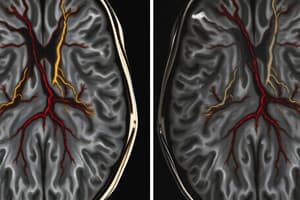Podcast
Questions and Answers
In medullary thyroid cancer (MTC), what is the principal origin of the tumor cells, and what substance do they produce?
In medullary thyroid cancer (MTC), what is the principal origin of the tumor cells, and what substance do they produce?
- Develops from parathyroid cells, secreting parathyroid hormone.
- Derives from follicular cells, generating triiodothyronine (T3).
- Originates from parafollicular C cells, synthesizing calcitonin. (correct)
- Arises from follicular cells, producing thyroglobulin.
What genetic mutation is most strongly associated with the development of medullary thyroid cancer (MTC)?
What genetic mutation is most strongly associated with the development of medullary thyroid cancer (MTC)?
- EGFR
- BRAF
- RET proto-oncogene (correct)
- TP53
A patient presents with a neck mass and chronic diarrhea. Which biochemical marker would be most indicative of medullary thyroid cancer (MTC)?
A patient presents with a neck mass and chronic diarrhea. Which biochemical marker would be most indicative of medullary thyroid cancer (MTC)?
- Elevated serum calcitonin (correct)
- Elevated serum thyroglobulin
- Elevated serum parathyroid hormone
- Elevated serum TSH
Why is fine-needle aspiration (FNA) with calcitonin staining considered a crucial step in the diagnostic evaluation of suspected medullary thyroid cancer (MTC)?
Why is fine-needle aspiration (FNA) with calcitonin staining considered a crucial step in the diagnostic evaluation of suspected medullary thyroid cancer (MTC)?
In patients with medullary thyroid cancer (MTC), what is the rationale behind performing a total thyroidectomy with central neck lymph node dissection?
In patients with medullary thyroid cancer (MTC), what is the rationale behind performing a total thyroidectomy with central neck lymph node dissection?
Which of the following is a primary indication for using tyrosine kinase inhibitors (TKIs) like cabozantinib or vandetanib in the management of medullary thyroid cancer (MTC)?
Which of the following is a primary indication for using tyrosine kinase inhibitors (TKIs) like cabozantinib or vandetanib in the management of medullary thyroid cancer (MTC)?
In the context of Multiple Endocrine Neoplasia type 2 (MEN 2) and its association with medullary thyroid cancer (MTC), what is the significance of prophylactic thyroidectomy in RET mutation carriers?
In the context of Multiple Endocrine Neoplasia type 2 (MEN 2) and its association with medullary thyroid cancer (MTC), what is the significance of prophylactic thyroidectomy in RET mutation carriers?
A patient with known medullary thyroid cancer (MTC) undergoes surgical resection. Postoperatively, what role does calcitonin monitoring play in their ongoing management?
A patient with known medullary thyroid cancer (MTC) undergoes surgical resection. Postoperatively, what role does calcitonin monitoring play in their ongoing management?
Which clinical manifestation is specifically associated with MEN 2B and not typically seen in MEN 2A?
Which clinical manifestation is specifically associated with MEN 2B and not typically seen in MEN 2A?
In cases of advanced medullary thyroid cancer (MTC) where surgical resection is not feasible, what is the primary goal of radiation therapy?
In cases of advanced medullary thyroid cancer (MTC) where surgical resection is not feasible, what is the primary goal of radiation therapy?
A patient diagnosed with sporadic medullary thyroid carcinoma (MTC) has a 10-year survival rate of approximately 75%. Which factor would most significantly alter this prognosis?
A patient diagnosed with sporadic medullary thyroid carcinoma (MTC) has a 10-year survival rate of approximately 75%. Which factor would most significantly alter this prognosis?
In the context of Multiple Endocrine Neoplasia type 2 (MEN 2), which of the following genetic characteristics is most indicative of an aggressive form of medullary thyroid carcinoma (MTC) and a correspondingly poorer prognosis?
In the context of Multiple Endocrine Neoplasia type 2 (MEN 2), which of the following genetic characteristics is most indicative of an aggressive form of medullary thyroid carcinoma (MTC) and a correspondingly poorer prognosis?
A 25-year-old patient is diagnosed with MEN 2B. Besides aggressive medullary thyroid carcinoma (MTC), which clinical finding would be most indicative of this specific subtype rather than MEN 2A?
A 25-year-old patient is diagnosed with MEN 2B. Besides aggressive medullary thyroid carcinoma (MTC), which clinical finding would be most indicative of this specific subtype rather than MEN 2A?
A patient is suspected of having MEN 2A syndrome. Which combination of clinical findings would provide the strongest basis for this diagnosis?
A patient is suspected of having MEN 2A syndrome. Which combination of clinical findings would provide the strongest basis for this diagnosis?
A newly identified RET mutation in exon 11 is found in a patient with a family history of MEN 2A. How does this information most directly influence the patient's clinical management?
A newly identified RET mutation in exon 11 is found in a patient with a family history of MEN 2A. How does this information most directly influence the patient's clinical management?
A patient with confirmed MEN 2A is undergoing evaluation for pheochromocytoma. Which of the following aspects regarding pheochromocytoma in MEN 2A is most critical for surgical planning?
A patient with confirmed MEN 2A is undergoing evaluation for pheochromocytoma. Which of the following aspects regarding pheochromocytoma in MEN 2A is most critical for surgical planning?
What is the underlying genetic mechanism behind Multiple Endocrine Neoplasia (MEN) syndromes?
What is the underlying genetic mechanism behind Multiple Endocrine Neoplasia (MEN) syndromes?
A child is diagnosed with MEN 2B due to an aggressive presentation of medullary thyroid carcinoma (MTC). What is the most crucial next step in managing this patient’s care?
A child is diagnosed with MEN 2B due to an aggressive presentation of medullary thyroid carcinoma (MTC). What is the most crucial next step in managing this patient’s care?
In managing a patient with MEN 2A, what is the rationale for prioritizing the surgical removal of a pheochromocytoma before addressing medullary thyroid carcinoma (MTC)?
In managing a patient with MEN 2A, what is the rationale for prioritizing the surgical removal of a pheochromocytoma before addressing medullary thyroid carcinoma (MTC)?
A patient with MEN 2A is found to have primary hyperparathyroidism. Which of the following pathological findings would you most expect to observe during parathyroid surgery?
A patient with MEN 2A is found to have primary hyperparathyroidism. Which of the following pathological findings would you most expect to observe during parathyroid surgery?
Flashcards
Medullary Thyroid Cancer (MTC)
Medullary Thyroid Cancer (MTC)
A neuroendocrine tumor from parafollicular C cells, producing calcitonin.
Pathophysiology of MTC
Pathophysiology of MTC
Originates from neural crest C cells; associates with RET mutations; metastasizes to lymph nodes and other organs.
Clinical Presentation of MTC
Clinical Presentation of MTC
Includes neck mass, dysphagia, diarrhea, flushing, and endocrine symptoms like hyperparathyroidism.
Biochemical Markers for MTC
Biochemical Markers for MTC
Signup and view all the flashcards
RET Proto-oncogene Mutation
RET Proto-oncogene Mutation
Signup and view all the flashcards
Total Thyroidectomy
Total Thyroidectomy
Signup and view all the flashcards
Adjuvant Treatment for MTC
Adjuvant Treatment for MTC
Signup and view all the flashcards
Familial Syndromes of MTC
Familial Syndromes of MTC
Signup and view all the flashcards
Calcitonin Monitoring
Calcitonin Monitoring
Signup and view all the flashcards
Imaging in MTC Diagnosis
Imaging in MTC Diagnosis
Signup and view all the flashcards
Annual screening for MTC
Annual screening for MTC
Signup and view all the flashcards
Sporadic MTC prognosis
Sporadic MTC prognosis
Signup and view all the flashcards
Familial MTC prognosis
Familial MTC prognosis
Signup and view all the flashcards
Stage-dependent survival
Stage-dependent survival
Signup and view all the flashcards
MEN syndromes
MEN syndromes
Signup and view all the flashcards
MEN 2A
MEN 2A
Signup and view all the flashcards
Pheochromocytoma
Pheochromocytoma
Signup and view all the flashcards
MTC genetics
MTC genetics
Signup and view all the flashcards
MEN 2B characteristics
MEN 2B characteristics
Signup and view all the flashcards
Prophylactic thyroidectomy
Prophylactic thyroidectomy
Signup and view all the flashcards
Study Notes
Medullary Thyroid Cancer (MTC)
- MTC arises from C cells in the thyroid, producing calcitonin.
- It's distinct from differentiated thyroid cancers (papillary and follicular).
- About 75% of cases are sporadic; 25% are familial, linked to MEN 2 syndromes.
- Originates from neural crest-derived C cells.
- Associated with RET proto-oncogene mutations.
- Commonly metastasizes to lymph nodes (cervical, mediastinal), lungs, liver, and bones.
- Typical presentation includes a painless, firm neck mass, potentially causing dysphagia or hoarseness.
- Diarrhea, flushing, and endocrine symptoms (e.g., hyperparathyroidism, pheochromocytoma) might occur.
Diagnostic Evaluation
- Biochemical Markers: Serum calcitonin (highly sensitive, linked to tumor burden), CEA (often high in advanced disease), & RET proto-oncogene mutation testing.
- Imaging: Thyroid ultrasound (initial), FNA with calcitonin staining (confirmation), CT/MRI for metastasis, PET-CT (advanced cases), MIBG/Octreotide scans (considering other neuroendocrine tumors).
Management
- Surgical Treatment (Localized): Total thyroidectomy with central neck lymph node dissection.
- Prophylactic thyroidectomy: For MEN 2 carriers (age dependent on mutation risk).
- Lateral neck dissection: For node-positive disease.
- Adjuvant Treatment (Metastatic/Advanced): Targeted therapy (tyrosine kinase inhibitors like cabozantinib, vandetanib), radiation therapy (palliation), calcitonin monitoring (residual/recurrent disease).
- Prognosis Sporadic MTC: ~75% 10-year survival. Familial MTC (esp. MEN 2B): poorer prognosis given early onset and aggressive nature.
Multiple Endocrine Neoplasia (MEN)
- MEN syndromes are hereditary, caused by mutations affecting cell growth, impacting multiple endocrine glands.
MEN 2
- MTC is a hallmark of MEN 2.
MEN 2A
- 100% MTC risk
- Pheochromocytoma (approx. 50%) – potentially life-threatening.
- Primary hyperparathyroidism (approx. 20-30%).
- RET mutations (exons 10, 11, 13, 14, 15, 16)
MEN 2B
- 100% MTC risk (often aggressive, early-onset)
- Pheochromocytoma (approx. 50%)
- Marfanoid habitus, mucosal neuromas (lips, tongue, etc.)
- No hyperparathyroidism.
- RET mutations (exons 15, 16); M918T mutation associated with poorer prognosis.
- Prophylactic thyroidectomy at an appropriate age.
Studying That Suits You
Use AI to generate personalized quizzes and flashcards to suit your learning preferences.




